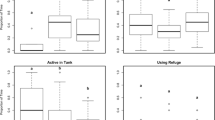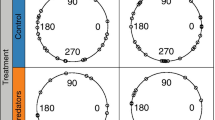Synopsis
Many species of shoaling fish are preyed upon by aerial predators. However, to date there has been no analysis of the evasive response of a group of shoaling fish to an aerial threat or attack. The response of a shoal of fish encompasses a suite of behaviors starting with a startle response. Shoals of golden shiner, Notemigonus crysoleucas, responded to the threat of aerial predation from a kingfisher model with a startle response, an increase in shoal depth, an increase in polarity, swimming in the opposite direction under the model predator, shoal compression along the depth axis, and shoal expansion on the plane perpendicular to the depth axis. It was hypothesized that shoal compression along the depth axis serves to increase predator confusion by placing more fish in the predator's visual field. This compression was termed the ‘plane of confusion’.
Similar content being viewed by others
References cited
Abrahams, M.V. & P.W. Colgan. 1985. Risk of predation, hydrodynamic efficiency and their influence on school structure. Env. Biol. Fish. 13: 195–202.
Bent, A.C. 1940. Life histories of North American cuckoos, goatsuckers, hummingbirds and their allies. Part 1. Dover Publications, New York. 506 pp.
Diamond, J. 1971. The Mauthner cell. pp. 265–346. In: W.S. Hoar & D.J. Randall (ed.) Fish Physiology, Vol. 5, Academic Press, New York.
Eaton, R.C. & R.A. Bombardieri. 1978. Behavioural functions of the Mauthner cell. pp. 221–244. In: D. Faber & H. Korn (ed.) Neurobiology of the Mauthner Cell, Raven Press, New York.
Eaton, R.C. & J.T. Hackett. 1984. The role of the Mauthner cell in fast starts involving escape in teleost fishes. pp. 213–262. In: R.C. Eaton (ed.) Neural Mechanisms of Startle Behavior, Plenum Press, New York.
Eaton, R.C. & R. DiDomenico. 1986. Role of teleost escape response during development. Trans. Amer. Fish. Soc. 115: 128–143.
Eaton, R.C., R.A. Bombardieri & D.L. Meyer. 1977. The Mauthner-initiated startle response in teleost fish. J. Exp. Biol. 66: 65–81.
Elson, P.F. 1962. Predator-prey relationships between fish-eating birds and Atlantic salmon. Fisheries Research Board of Canada Bulletin 133, Ottawa. 87 pp.
Fraser, J.M. 1974. An attempt to train hatchery-reared brook trout to avoid predation by the common loon. Trans. Amer. Fish. Soc. 103: 815–818.
Giles, N. 1983. Behavioural effect of the parasite Schistocephalus solidus (Cestoda) on an intermediate host, the threespined stickleback, Gasterosteus aculeatus L.. Anim. Behav. 31: 1192–1194.
Giles, N. & F.A. Huntingford. 1984. Predation risk and interpopulation variation in anti-predator behaviour in the threespined stickleback, Gasterosteus aculeatus L.. Anim. Behav. 32: 264–275.
Hamilton, W.D. 1971. Geometry of the selfish herd. J. Theor. Biol. 31: 295–311.
Hover, E.E. 1936. Fish-eating birds. Prog. Fish-Cult. 21: 21–22.
Kramer, D.L., D. Manley & R. Bourgeois. 1983. The effects of respiratory and oxygen concentration on the risk of aerial predation in fishes. Can. J. Zool. 61: 653–665.
Kushlan, J.A. 1976. Feeding behaviour of North American herons. The Auk 93: 86–94.
Landau, L. & J. Terborgh. 1986. Oddity and the ‘confusion effect’ in predation. Anim. Behav. 34: 1372–1380.
Litvak, M.K. 1983. Method for measuring small fish. Prog. Fish-Cult. 45: 61.
Litvak, M.K. 1990. Predator avoidance, foraging behaviour and social transmission of information in fish shoals. Ph.D. Dissertation, University of Toronto, Toronto. 113 pp.
Magurran, A.E. 1990. The adaptive significance of schooling as anti-predator defence in fish. Ann. Zool. Fennici 27: 51–66.
Milinski, M. 1977. Experiments on the selection by predators against spatial oddity of their prey. Z. Tierpsychol. 43: 311–325.
Milinski, M. 1979. Can an experienced predator overcome the confusion of swarming prey more easily? Anim. Behav. 27: 1122–1126.
Milinski, M. 1984. A predator's cost of overcoming the confusion effect of swarming prey. Anim. Behav. 32: 1157–1162.
Milinski, M. & R. Heller. 1978. Influence of a predator on the optimal foraging behaviour of sticklebacks (Gasterosteus aculeatus L.). Nature 275: 642–644.
Neill, S.R. Jr. & J.M. Cullen. 1974. Experiments on whether schooling by their prey affects the hunting behaviour of cephalopod and fish predators. J. Zool. (Lond.) 172: 549–569.
Partridge, B.L. & T.J. Pitcher. 1980. The sensory basis of fish schools: relative roles of lateral line and vision. J. Comp. Physiol. A 135: 315–325.
Pitcher, T.J. 1986. Functions of shoaling behavior in teleosts. pp. 294–337. In: T.J. Pitcher (ed.) The Behavior of Teleost Fishes, Johns Hopkins University Press, Baltimore.
Power, M.E. 1984. Depth distributions of armoured catfish: predator-induced resource avoidance? Ecology 65: 523–528.
Reimchen, T.E. 1988. Inefficient predators and prey injuries in a population of giant stickleback. Can. J. Zool. 66: 2036–2044.
Salyer, J.C. II. & K.F. Lagler. 1946. The eastern belted kingfisher, Megaceryle alcyon alcyon (Linnaeus), in relation to fish management. Trans. Amer. Fish. Soc. 76: 96–117.
Schramm, H.L. Jr. M.W. Collopy & E.A. Okrah. 1987. Potential problems of bird predation for fish culture in Florida. Prog. Fish-Cult. 49: 44–49.
Seghers, B.H. 1974a. Geographic variation in the responses of guppies (Poecilia reticulata) to aerial predators. Oecologia (Berl.) 14: 93–98.
Seghers, B.H. 1974b. Schooling behaviour in the guppy (Poecilia reticulata): an evolutionary response to predation. Evol. 28: 486–489.
Sokal, R.R. & F.J. Rohlf. 1981. Biometry. Freeman and Co., San Francisco. 859 pp.
Winer, B.J. 1971. Statistical principles in experimental design. John Wiley, New York. 907 pp.
Wood, C.C. 1986. Dispersion of common merganser (Mergus merganser) breeding pairs in relation to the availability of juvenile Pacific salmon in Vancouver Island streams. Can. J. Zool. 64: 756–765.
Author information
Authors and Affiliations
Rights and permissions
About this article
Cite this article
Litvak, M.K. Response of shoaling fish to the threat of aerial predation. Environ Biol Fish 36, 183–192 (1993). https://doi.org/10.1007/BF00002798
Received:
Accepted:
Issue Date:
DOI: https://doi.org/10.1007/BF00002798




